Gastroprotective Effects of Aqueous Extracts of Broccoli Stems on Acute Injury in Rats: A Comprehensive Evaluation of Gastric Function and Inflammatory Responses
Abstract
1. Introduction
2. Materials and Methods
2.1. Preparation of Broccoli Stem Extract
2.2. Measurement of Antioxidant Capacity
2.2.1. DPPH Radical Scavenging Activity
2.2.2. ABTS Radical Scavenging Activity
2.2.3. Total Polyphenol Content
2.3. Animal Experiments
2.4. HCl/EtOH-Induced Acute Gastric Damage Animal Model
- ➢
- Normal: Normal control group, only DW administration.
- ➢
- Control: HCl/EtOH model group, administration of 150 mM HCl/60% ethanol and DW.
- ➢
- MMSC: Positive control group, administration of 150 mM HCl/60% ethanol + Methyl Methionine Sulfonium Chloride 50 mg/kg.
- ➢
- BSE groups: Experimental groups, administration of 150 mM HCl/60% ethanol + broccoli stem extracts (BSE) 50, 125, and 250 mg/kg (BSE 50, BSE 125, BSE 250, respectively).
Evaluation of Clinical Signs
- 1 point: Normal walking and excited behavior;
- 5 points: Reduced movement compared to normal activity;
- 10 points: Slight movement observed only upon stimulation or minimal spontaneous activity;
- 15 points: Severe signs such as breathlessness and deep breathing.
2.5. Histological Analysis
2.6. Macroscopic and Microscopic Evaluation of Stomach Tissues
2.7. ELISA Assay
2.8. Quantitiative Real-Time PCR (qRT-PCR) Analysis
2.9. Western Blotting
2.10. Cisplatin-Induced Gastrointestinal Dysmotility Model
- ➢
- Normal: DW only;
- ➢
- Control: Cisplatin i.p. injection + DW;
- ➢
- Itopride: Cisplatin i.p. injection + itopride (30 mg/kg);
- ➢
- BSE groups: Cisplatin i.p. injection + BSE (50, 125, 250 mg/kg).
2.11. Measurement of Gastrointestinal Motility and Established Animal Model
- ➢
- Normal: Normal control group, only DW administration.
- ➢
- Control: Vehicle, atropine 1 mg/kg, negative control group.
- ➢
- Mosapirde: Positive control group, atropine 1 mg/kg + Mosapride 10 mg/kg.
- ➢
- BSE groups: Experimental groups, atropine 1 mg/kg + broccoli stems extracts (BSE) 50, 125, and 250 mg/kg (BSE 50, BSE 125, BSE 250, respectively).
2.12. Measurement of Anti-Secretory Activity in Pyloric Ligation
- ➢
- Control: Vehicle, negative control, pyloric ligation.
- ➢
- MMSC: Positive control, Methyl Methionine Sulfonium Chloride 50 mg/kg, pyloric ligation.
- ➢
- BSE groups: Experimental groups, administration of broccoli stem extracts (BSE) 50, 125, and 250 mg/kg (BSE 50, BSE 125, BSE 250, respectively), pyloric ligation.
2.13. Statistical Analysis
3. Results
3.1. Antioxidant Activity of BSE
3.2. Effects of BSE on Clinical Signs After HCl/EtOH-Induced Acute Gastric Injury
3.3. Effects of BSE on HCl/EtOH-Induced Gastric Lesion and Mucosa Damage
3.4. Effects of BSE on Histological Analysis in HCl/EtOH-Induced Rats
3.5. Effects of BSE on NADPH Oxidase in HCl/EtOH-Induced Rats
3.6. Effects of BSE on NF-κB Signaling Pathway in HCl/EtOH-Induced Rats
3.7. Effects of BSE on Gastric Emptying in Cisplatin-Induced Rats
3.8. Effects of BSE on Gastrointestinal Motility in Atropine-Induced Rats
3.9. Effects of BSE on Gastric Secretion in Pyloric Ligation Rat Model
4. Discussion
5. Conclusions
Author Contributions
Funding
Institutional Review Board Statement
Informed Consent Statement
Data Availability Statement
Conflicts of Interest
References
- Simõs, S.; Lopes, R.; Campos, M.C.D.; Marruz, M.J.; da Cruz, M.E.M.; Corvo, L. Animal models of acute gastric mucosal injury: Macroscopic and microscopic evaluation. Anim. Models Exp. Med. 2019, 2, 121–126. [Google Scholar] [CrossRef] [PubMed]
- Zhang, C.; Gao, F.; Gan, S.; He, Y.; Chen, Z.; Liu, X.; Fu, C.; Qu, Y.; Zhang, J. Chemical characterization and gastroprotective effect of an isolated polysaccharide fraction from Bletilla striata against ethanol-induced acute gastric ulcer. Food Chem. Toxicol. 2019, 131, 110539. [Google Scholar] [CrossRef] [PubMed]
- Gong, G.; Zhao, R.; Zhu, Y.; Yu, J.; Wei, B.; Xu, Y.; Cui, Z.; Liang, G. Gastroprotective effect of cirsilineol against hydrochloric acid/ethanol-induced gastric ulcer in rats. Korean J. Physiol. Pharmacol. 2021, 25, 403–411. [Google Scholar] [CrossRef] [PubMed]
- Kim, Y.S.; Lee, J.H.; Song, J.; Kim, H. Gastroprotective effects of inulae flos on HCl/Ethanol-induced gastric ulcers in rats. Molecules 2020, 25, 5623. [Google Scholar] [CrossRef] [PubMed]
- Vona, R.; Pallotta, L.; Cappelletti, M.; Severi, C.; Matarrese, P. The impact of oxidative stress in human pathology: Focus on gastrointestinal disorders. Antioxidants 2021, 10, 201. [Google Scholar] [CrossRef]
- Ala, M.; Jafari, R.M.; Ala, M.; Agbele, A.T.; Hejazi, S.M.; Tavangar, S.M.; Mahdavi, S.R.M.; Dehpour, A.R. Sumatriptan alleviates radiation-induced oral mucositis in rats by inhibition of NF-kB and ERK activation, prevention of TNF-α and ROS release. Arch. Oral. Biol. 2020, 119, 104919. [Google Scholar] [CrossRef]
- Minatel, I.O.; Francisqueti, F.V.; Corrêa, C.R.; Lima, G.P.P. Antioxiant activity of γ-Oryzanol: A complex network of interactions. Int. J. Mol. Sci. 2016, 17, 1107. [Google Scholar] [CrossRef] [PubMed]
- Lenti, M.V.; Rugge, M.; Lahner, E.; Miceli, E.; Toh, B.-H.; Genta, R.M.; De Block, C.; Hershko, C.; Di Sabatino, A. Autoimmune gastritis. Nat. Rev. Dis. Primers 2020, 6, 56. [Google Scholar] [CrossRef]
- Herszényi, L.; Bakucz, T.; Barabás, L.; Tulassay, Z. Pharamacological approach to gastric acid suppression: Past, present, and future. Dig. Dis. 2020, 38, 104–111. [Google Scholar] [CrossRef]
- Pali-Schöll, I.; Jensen-Jarolim, E. Anti-acid medication as a risk factor for food allergy. Allergy 2011, 66, 469–477. [Google Scholar] [CrossRef] [PubMed]
- Canani, R.B.; Cirillo, P.; Roggero, P.; Romano, C.; Malamisura, B.; Terrin, G.; Passariello, A.; Manguso, F.; Morelli, L.; Guarino, A.; et al. Therapy with gastric acidity inhibitors increases the risk of acute gastroenteritis and community-acquired pneumonia in children. Pediatrics 2006, 117, e817–e820. [Google Scholar] [CrossRef] [PubMed]
- Kao, L.; Liu, T.-H.; Tsai, T.-Y.; Pan, T.-M. Beneficial effects of the commercial lactic acid bacteria product, Vigiis 101, on gastric mucosa and intestinal bacterial flora in rats. J. Microbiol. Immunol. Infect. 2020, 53, 266–273. [Google Scholar] [CrossRef] [PubMed]
- Symonds, E.L.; Tran, C.D.; Butler, R.N.; Omari, T.I. Gastric emptying is altered with the presence of gastritis. Dig. Dis. Sci. 2008, 53, 636–641. [Google Scholar] [CrossRef] [PubMed]
- Kalkan, Ҫ.; Soykan, I.; Soydal, Ҫ.; Özkan, E.; Kalkan, E. Assessment of gastric emptying in patient with autoimmune gastritis. Dig. Dis. Sci. 2016, 61, 1597–1602. [Google Scholar] [CrossRef] [PubMed]
- Goyal, R.K.; Guo, Y.; Mashimo, H. Advances in the physiology of gastric emptying. Neurogastroenterol. Motil. 2019, 31, e13546. [Google Scholar] [CrossRef]
- Ryou, S.H.; Cho, I.J.; Choi, B.-R.; Kim, M.B.; Kwon, Y.S.; Ku, S.K. Brassica oleracea var. capitata L. alleviates indomethacin-induced acute gastric injury by enhancing anti-inflammatory and antioxidant activity. Processes 2021, 9, 372. [Google Scholar] [CrossRef]
- Leonti, M.; Casu, L. Traditional medicines and globalization: Current and future perspectives in ethnopharmacology. Front. Pharmacol. 2013, 25, 92. [Google Scholar] [CrossRef]
- Syed, R.U.; Moni, S.S.; Break, M.K.B.; Khojali, W.M.A.; Jafar, M.; Alshammari, M.D.; Abdelsalam, K.; Taymour, S.; Alreshidi, K.S.M.; Elhassan Taha, M.M.E.; et al. Broccoli: A multi-faceted vegetable for health: An in-depth review of its nutritional attributes, antimicrobial abilities, and anti-inflammatory properties. Antibiotics 2023, 12, 1157. [Google Scholar] [CrossRef]
- Duque-Buitrago, L.F.; Mornero-Martínez, A.; Castañeda, V.; Mora-Escobedo, R. Use of food and food-derived products in the treatment of gastritis: A systematic review. Crit. Rev. Food Sci. Nutr. 2023, 63, 5771–5782. [Google Scholar] [CrossRef] [PubMed]
- Šamec, D.; Urlić, B.; Salopek-Sondi, B. Kale (Brassica oleracea var. acephala) as a superfood: Review of the scientific evidence behind the statement. Crit. Rev. Food Sci. Nutr. 2019, 59, 2411–2422. [Google Scholar] [CrossRef] [PubMed]
- Latté, K.P.; Appel, K.-E.; Lampen, A. Health benefits and possible risks of broccoli—An overview. Food Chem. Toxicol. 2011, 49, 3287–3309. [Google Scholar] [CrossRef] [PubMed]
- Favela-González, K.M.; Hernández-Almanza, A.Y.; De la Fuente-Salcido, N.M. The value of bioactive compounds of cruciferous vegetables (Brassica) as antimicrobials and antioxidants: A review. J. Food Biochem. 2020, 44, e13414. [Google Scholar] [CrossRef]
- Yahfoufi, N.; Alsadi, N.; Jambi, M.; Matar, C. The immunomodulatory and anti-inflammatory role of polyphenols. Nutrients 2018, 10, 1618. [Google Scholar] [CrossRef] [PubMed]
- Abdull Razis, A.F.; Noor, N.M. Cruciferous vegetables: Dietary phytochemicals for cancer prevention. Asian Pac. J. Cancer Prev. 2013, 14, 1565–1570. [Google Scholar] [CrossRef] [PubMed]
- Wu, Y.; Perry, A.K.; Klein, B.P. Vitamin C and β-carotene in fresh and frozen green beans and broccoli in a simulated system. J. Food Quai 1992, 15, 87–96. [Google Scholar] [CrossRef]
- Hu, C.H.; Zuo, A.Y.; Wang, D.G.; Pan, H.Y.; Zheng, W.B.; Qian, Z.C.; Zou, X.T. Effects of broccoli stems and leaves meal on production performance and egg quality of laying hens. Anim. Feed. Sci. Technol. 2011, 170, 117–121. [Google Scholar] [CrossRef]
- Liu, M.; Zhang, L.; Ser, S.L.; Cumming, J.R.; Ku, K.-M. Comparative phytonutrient analysis of broccoli by-products: The potentials for broccoli by-product utilization. Molecules 2018, 23, 900. [Google Scholar] [CrossRef] [PubMed]
- Gulcin, İ.; Alwasel, S.H. DPPH radical scavenging assay. Processes 2023, 11, 2248. [Google Scholar] [CrossRef]
- Sánchez-Moreno, C. Review: Methods used to evaluate the free radical scavenging activity in foods and biological systems. Food Sci. Technol. Int. 2002, 8, 121–137. [Google Scholar] [CrossRef]
- Zhang, Q.; Zhang, J.; Shen, J.; Silva, A.; Dennis, D.A.; Barrow, C.J. A simple 96-well microplate method for estimation of total polyphenol content in seaweeds. J. Appl. Phycol. 2006, 18, 445–450. [Google Scholar] [CrossRef]
- Charan, J.; Kantharia, N.D. How to calculate sample size in animal studies? J. Pharmacol. Pharmacother. 2013, 4, 303–306. [Google Scholar] [CrossRef] [PubMed]
- Watanabe, T.; Ohara, S.; Ichikawa, T.; Saigenji, K.; Hotta, K. Mechanisms for cytoprotection by vitamin U from ethanol-induced gastric mucosal damage in rats. Dig. Dis. Sci. 1996, 41, 49–54. [Google Scholar] [CrossRef] [PubMed]
- Watanabe, T.; Ohara, S.; Miyazawa, S.; Saigenji, K.; Hotta, K. Augmentative effects of L-cysteine and methylmethoionine sulfonium chloride on mucin secretion in rabbit gastric mucous cells. J. Gastroenterol. Hepatol. 2000, 15, 45–52. [Google Scholar] [CrossRef] [PubMed]
- Jeon, E.-J.; Choi, J.-H.; Lee, N.-Y.; Oh, H.-J.; Kwon, H.-S.; Kwon, J. Gastroprotective effects of fermented gold kiwi (Actinidia chinenesis L.) extracts on HCl/EtOH-induced gastric injury in rats. Appl. Sci. 2022, 12, 5271. [Google Scholar] [CrossRef]
- Sharma, S.S.; Gupta, Y.K. Reversal of cisplatin-induced delay in gastric emptying in rats by ginger (Zingiber officinale). J. Ethnopharmacol. 1998, 62, 49–55. [Google Scholar] [CrossRef] [PubMed]
- Yang, N.-N.; Yang, J.-W.; Ye, Y.; Huang, J.; Wang, L.; Wang, Y.; Su, X.-T.; Lin, Y.; Yu, F.-T.; Ma, S.-M.; et al. Electroacupuncture ameliorates intestinal inflammation by activating α7nAChR-mediated JAK2/STAT3 signaling pathwway in postoperative ileus. Theranostics 2021, 11, 4078–4089. [Google Scholar] [CrossRef]
- Kim, Y.-S.; Park, H.J.; Kim, H.; Song, J.; Lee, D. Gastroprotective effects of paeonia extract mixture HT074 against experimental gastric ulcers in rats. Evid. Based Complement. Altern. Med. 2019, 2019, 3546258. [Google Scholar] [CrossRef] [PubMed]
- Anson, M.L. The estimation of pepsin, trypsin, papain, and cathepsin with hemoglobin. J. Gen. Physiol. 1938, 22, 79–89. [Google Scholar] [CrossRef] [PubMed]
- Thomas, M.; Badr, A.; Desjardins, Y.; Gosselin, A.; Anger, P. Characterization of industrial broccoli discards (Brassica oleracea var. italica) for their glucosinolate, polyphenol and flavonoid content using UPLC MS/MS and spectrophotometric methods. Food Chem. 2018, 245, 1204–1211. [Google Scholar] [CrossRef]
- Rivas, M.Á.; Benito, M.J.; Martín, A.; de Guía Córdoba, M.; Ruíz-Moyano, S.; Casquete, R. Improve the functional properties of dietary fibre isolated from broccoli by-products by using different technologies. Innov. Food Sci. Emerg. Technol. 2022, 80, 103075. [Google Scholar] [CrossRef]
- Silva, M.S.; de Andrade Gomes, Y.; de Sousa Cavalcante, M.L.; Telles, P.V.N.; da Silva, A.C.A.; Severo, J.S.; de Oliveira Santos, R.; Dos Santos, B.L.B.; Cavalcante, G.L.; Rocha, C.H.L.; et al. Exercise and pyridostigmine prevents gastric emptying delay and increase blood pressure and cisplatin-induced baroreflex sensitivity in rats. Life Sci. 2021, 267, 118972. [Google Scholar] [CrossRef]
- Burger, D.M.; Wiestner, T.; Hubler, M.; Binder, H.; Keiser, M.; Arnold, S. Effect of anticholinergics (atropine, glycopyrrolate) and prokinetics (metoclopramide, cisapride) on gastric motility in beagles and labrador retrievers. J. Vet. Med. A Physiol. Clin. Med. 2006, 53, 97–107. [Google Scholar] [CrossRef] [PubMed]
- Uchida, M.; Yoshida, K.; Shimizu, K. Effect of atropine sulfate on gastric emptying and gastrocecal transit time evaluated by using the [1-(13)C]acetic acid and lactose-[(13)C]ureide breath test in conscious rats. J. Breath. Res. 2009, 3, 047003. [Google Scholar] [CrossRef]
- Li, F.; Sun, H.; Ran, G.; Liu, X.; Yi, R.; Tan, F.; Zhao, X.; Liu, H. Preventive effect of Lactobacillus plantarum HFY09 on HCl/ethanol-induced gastric injury in mice. Appl. Biol. Chem. 2020, 63, 49. [Google Scholar] [CrossRef]
- Shin, J.-K.; Park, J.H.; Kim, K.S.; Kang, T.H.; Kim, H.S. Antiulcer activity of steamed ginger extract against ethanol/HCl-induced gastric mucosal injury in rats. Molecules 2020, 25, 4663. [Google Scholar] [CrossRef] [PubMed]
- Chen, S.; Zhao, X.; Sun, P.; Qian, J.; Shi, Y.; Wang, R. Preventive effect of Gardenia jasminoides on HCl/ethanol induced gastric injury in mice. J. Pharmacol. Sci. 2017, 133, 1–8. [Google Scholar] [CrossRef] [PubMed]
- Suo, H.; Zhao, X.; Qian, Y.; Sun, P.; Zhu, K.; Li, J.; Sun, B. Lactobacillus fermentum suo attenuates HCl/ethanol induced gastric injury in mice through its antioxidant effects. Nutrients 2016, 8, 155. [Google Scholar] [CrossRef] [PubMed]
- Park, S.; An, I.; Noh, G.; Yoo, B.H.; Lee, J.R. Inhibitory effects of broccoli leaf extract on PGE2 production by NF-κB inhibition. Korean J. Herbol. 2019, 34, 117–124. [Google Scholar] [CrossRef]
- Gudiño, I.; Casquete, R.; Martin, A.; Wu, Y.; Benito, M.J. Comprehensive analysis of bioactive compounds, functional properties, and applications of broccoli by-products. Foods 2024, 13, 3918. [Google Scholar] [CrossRef] [PubMed]
- Wang, R.; Sun, F.; Ren, C.; Zhai, L.; Xiong, R.; Yang, Y.; Yang, W.; Yi, R.; Li, C.; Zhao, X. Hunan insect tea polyphenols provide protection against gastric injury induced by HCl/ethanol through an antioxidant mechanism in mice. Food Funct. 2021, 12, 747–760. [Google Scholar] [CrossRef]
- Khushtar, M.; Kumar, V.; Javed, K.; Bhandari, U. Protective effect of ginger oil on aspirin and pylorus ligation-induced gastric ulcer model in rats. Indian. J. Pharm. Sci. 2009, 71, 554–558. [Google Scholar] [CrossRef]
- El-Naga, R.N. Apocynin protects against ethanol-induced gastric ulcer in rats by attenuating the upregulation of NADPH oxidases 1 and 4. Chem. Biol. Interact. 2015, 242, 7–326. [Google Scholar] [CrossRef] [PubMed]
- Padovan, J.C.; Dourado, T.M.H.; Pimenta, G.F.; Bruder-Nascimento, T.; Tirapelli, C.R. Reactive oxygen species are central mediators of vascular dysfunction and hypertension induced by ethanol consumption. Antioxidants 2023, 12, 1813. [Google Scholar] [CrossRef]
- Blanca, A.J.; Ruiz-Armenta, M.V.; Zambrano, S.; Miguel-Carrasco, J.L.; González-Roncero, F.M.; Fortuño, A.; Revilla, E.; Mate, A.; Vázquez, C.M. l-Carnitine ameliorates the oxidative stress response to angiotensin II by modulating NADPH oxidase through a reduction in protein kinase c activity and NF-κB translocation to the nucleus. Food Chem. 2017, 228, 356–366. [Google Scholar] [CrossRef] [PubMed]
- Chaithongyot, S.; Jantaree, P.; Sokolova, O.; Naumann, M. NF-κB in gastric cancer development and therapy. Biomedicines 2021, 9, 870. [Google Scholar] [CrossRef]
- Zhang, T.; Ma, C.; Zhang, Z.; Zhang, H.; Hu, H. NF-κB signaling in inflammation and cancer. MedComm 2021, 2, 618–653. [Google Scholar] [CrossRef] [PubMed]
- Al Asmari, A.; Al Shahrani, H.; Al Masri, N.; Al Faraidi, A.; Elfaki, I.; Arshaduddin, M. Vanillin abrogates ethanol induced gastric injury in rats via modulation of gastric secretion, oxidative stress and inflammation. Toxicol. Rep. 2015, 3, 105–113. [Google Scholar] [CrossRef]
- Aziz, R.S.; Siddiqua, A.; Shahzad, M.; Shabbir, A.; Naseem, N. Oxyresveratrol ameliorates ethanol-induced gastric ulcer via downregulation of IL-6, TNF-α, NF-ĸB, and COX-2 levels, and upregulation of TFF-2 levels. Biomed. Phrmacother 2019, 110, 554–560. [Google Scholar] [CrossRef] [PubMed]
- Prayoga, D.K.; Aulifa, D.L.; Budiman, A.; Levita, J. Plant with anti-ulcer activity and mechanism: A review of preclinical and clinical studies. Drug Des. Devel Ther. 2024, 18, 193–213. [Google Scholar] [CrossRef] [PubMed]
- Tanaka, T.; Narazaki, M.; Masuda, K.; Kishimoto, T. Regulation of IL-6 in immunity and disease. Adv. Exp. Med. Biol. 2016, 941, 79–88. [Google Scholar] [CrossRef]
- Bessler, H.; Djaldetti, M. Broccoli and human health: Immunomodulatory effect of sulforaphane in a model of colon cancer. Int. J. Food Sci. Nutr. 2018, 69, 946–953. [Google Scholar] [CrossRef]
- Deramaudt, T.B.; Ali, M.; Vinit, S.; Bonay, M. Sulforaphane reduces intracellular survival of Staphylococcus aureus in macrophages through inhibition of JNK and p38 MAPK-induced inflammation. Int. J. Mol. Med. 2020, 45, 1927–1941. [Google Scholar] [CrossRef] [PubMed]
- Gottfried-Blackmore, A.; Namkoong, H.; Adler, E.; Martin, B.; Gubatan, J.; Fernandez-Becker, N.; Clarke, J.O.; Idoyaga, J.; Nguyen, L.; Habtezion, A. Gastric mucosal immune profiling and dysregulation in idiopathic gastroparesis. Clin. Transl. Gastroenterol. 2021, 12, e00349. [Google Scholar] [CrossRef]
- Camilleri, M. Gastrointestinal motility disorders in neurologic disease. J. Clin. Invest. 2021, 131, e143771. [Google Scholar] [CrossRef] [PubMed]
- Tang, D.M.; Friedenberg, F.K. Gastroparesis: Approach, diagnostic evaluation, and management. Dis. Mon. 2011, 57, 74–101. [Google Scholar] [CrossRef] [PubMed]


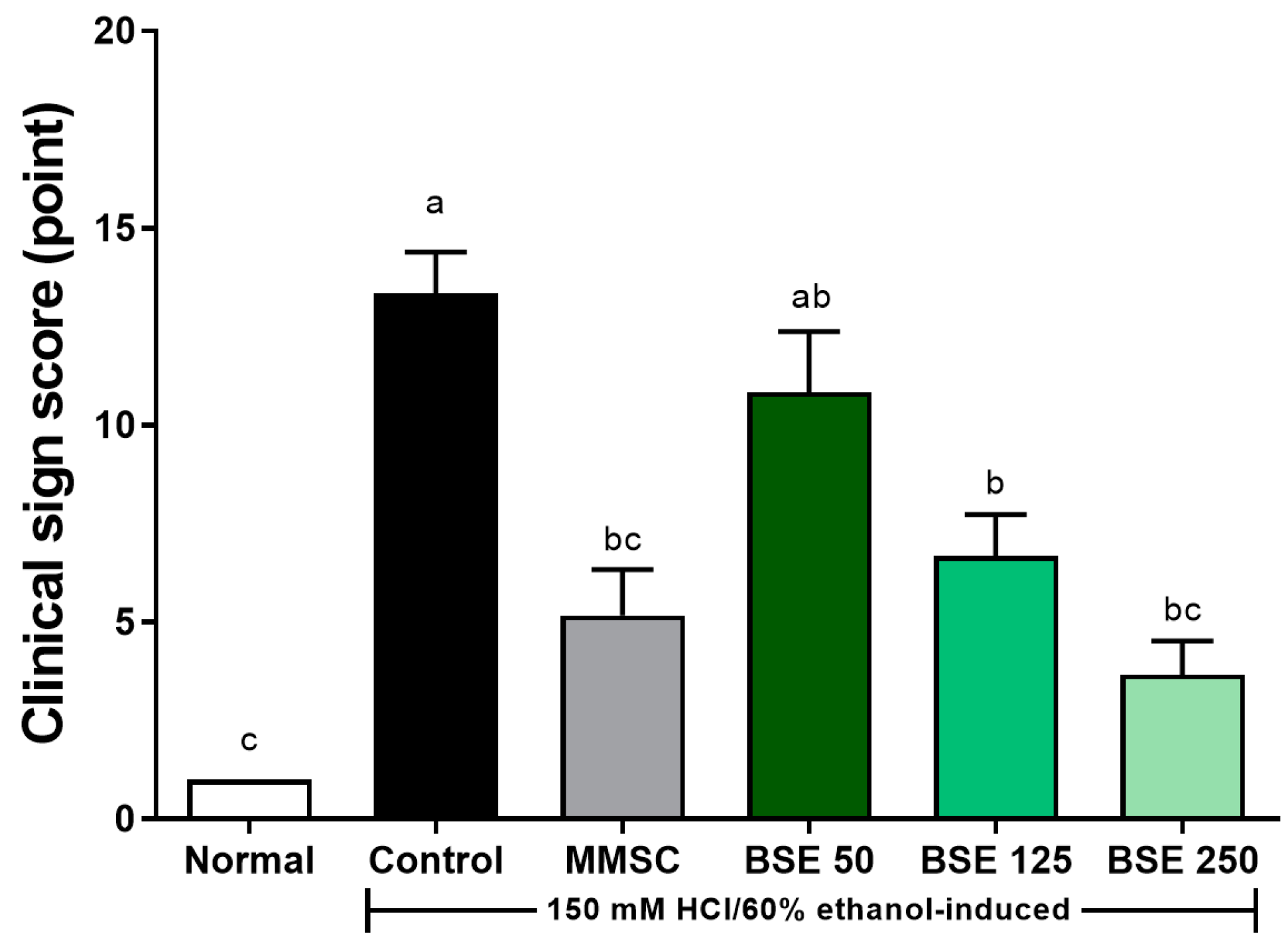

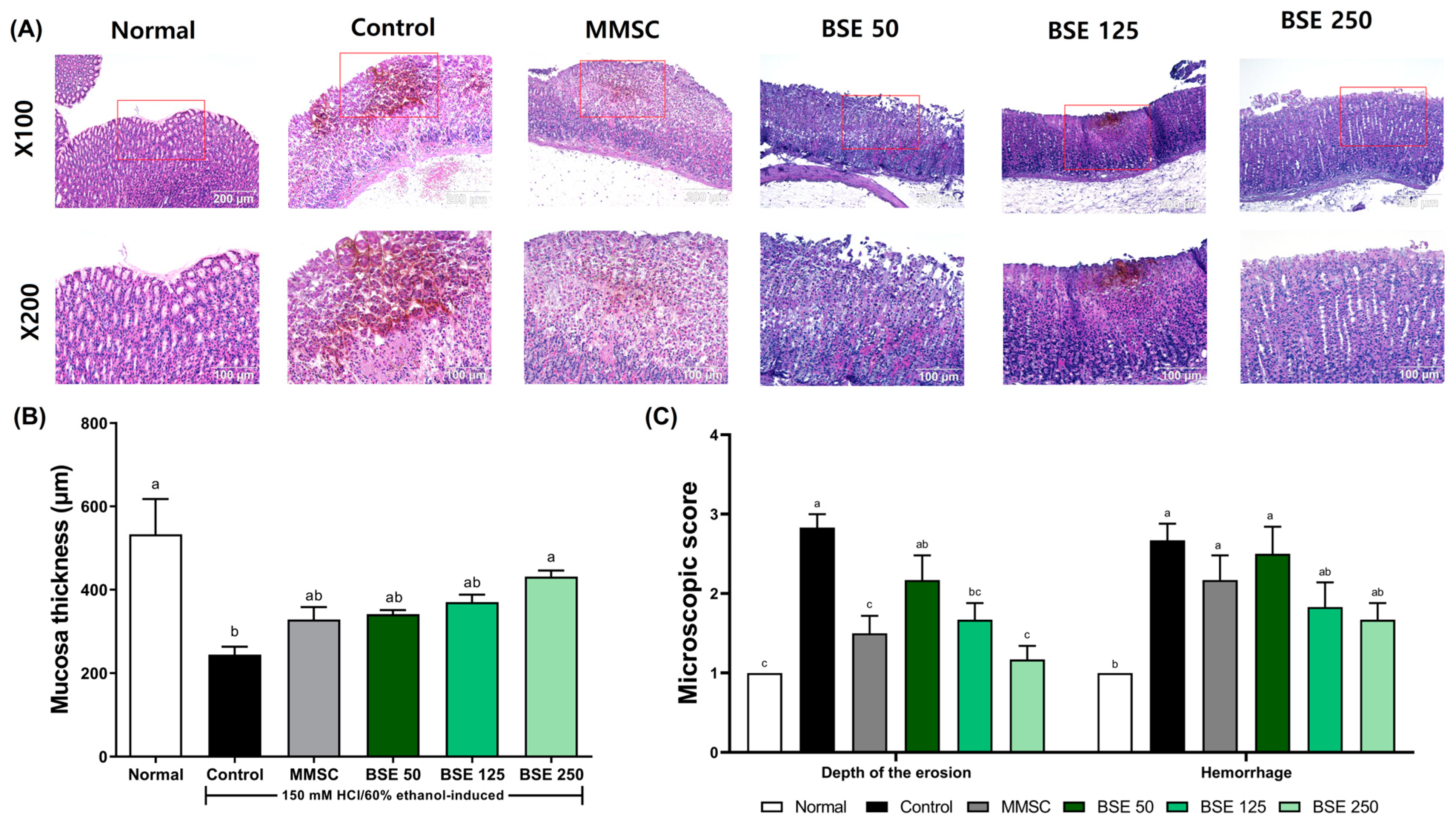
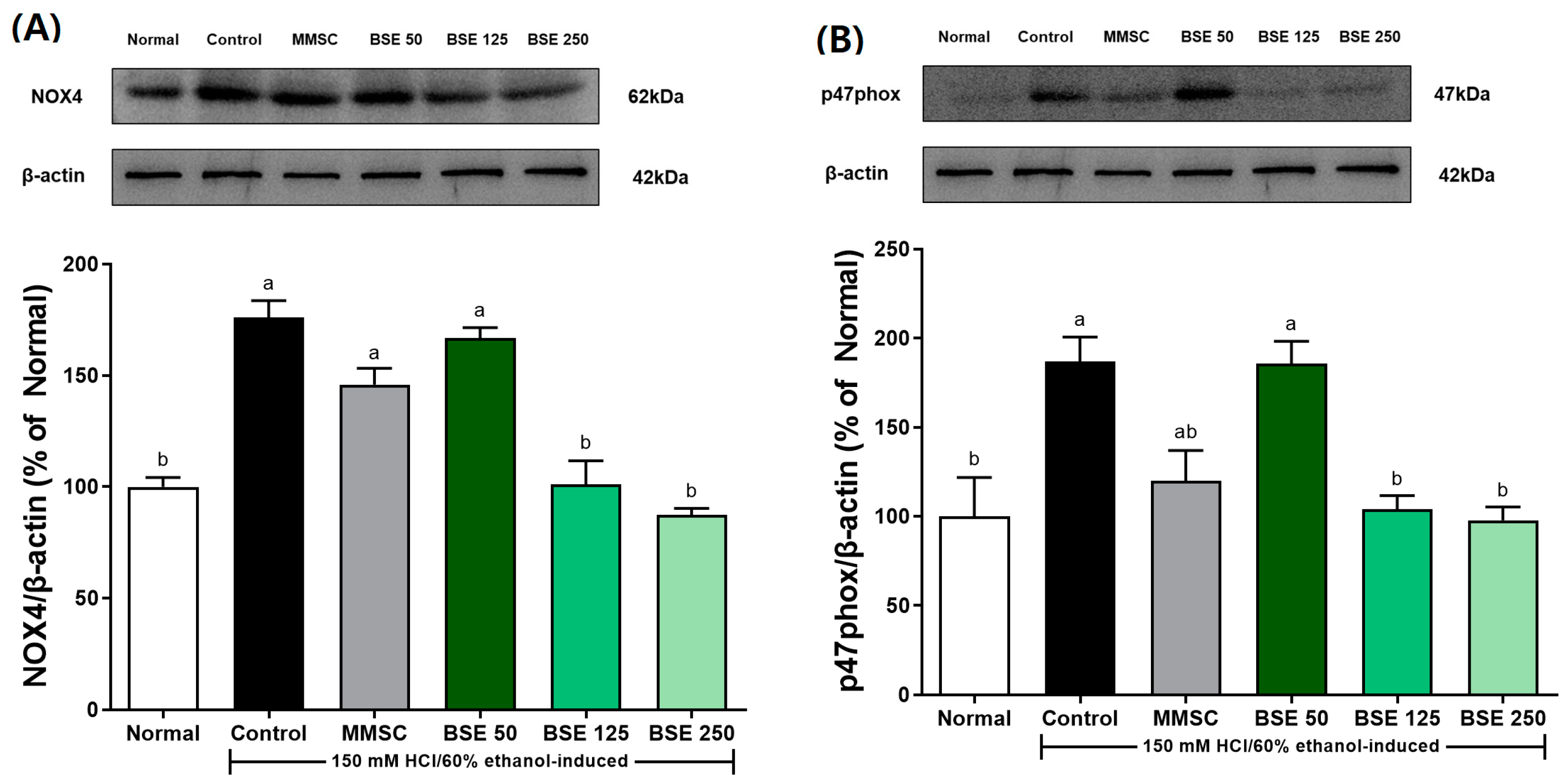




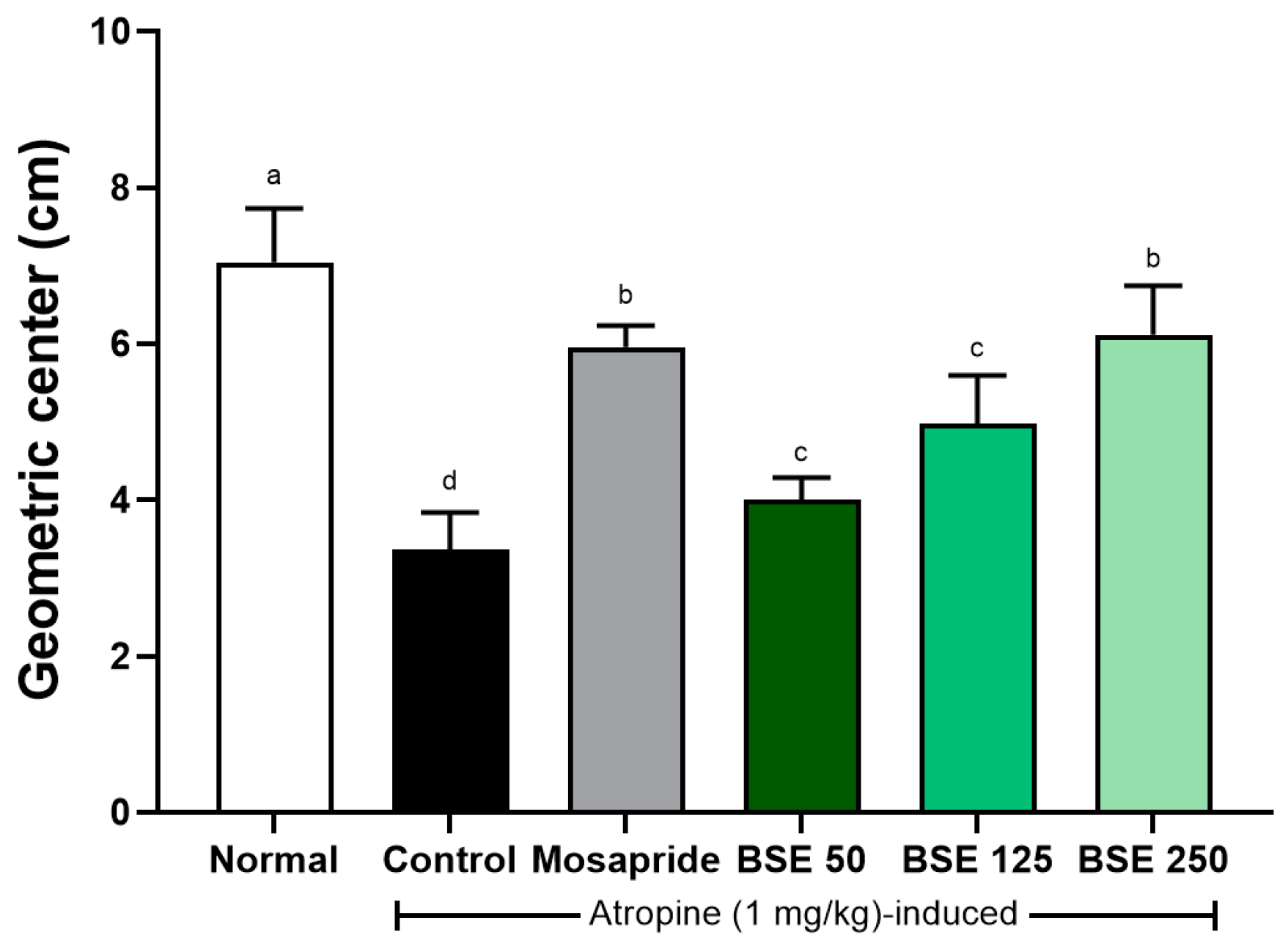
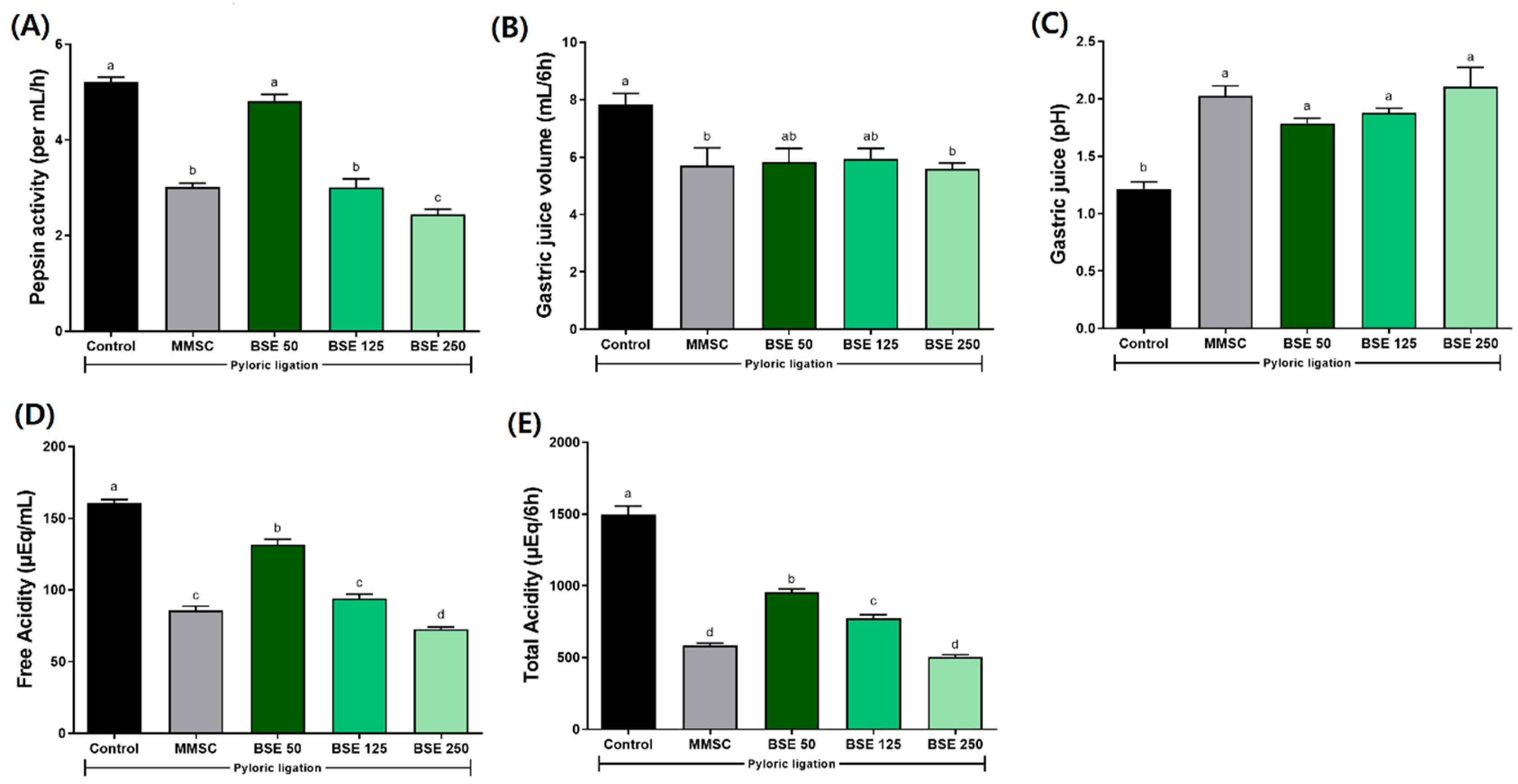
| Macroscopic | |||
|---|---|---|---|
| Hemorrhage | Score 1 | Score 2 | Score 3 |
| Size | Punctiform (focal < 2 mm) | Mild (2–5 mm) | Intense or in band (<5 mm) |
| Number | 0–4 | 5–6 | ≥7 |
| Site | Unilaterals | Bilaterals | |
| Microscopic | |||
| Score | 1 | 2 | 3 |
| Depth of the erosion | Up to 1/3 of total mucosa depth | Up to 1/3 of total mucosa depth | Total mucosa |
| Hemorrhage | Focal | Mild | Severe |
| Gene Name | Sequence of PCR Primer (5′-3′) | |
|---|---|---|
| TNF-α | F | TGATCCGAGATGTGGAACTG |
| R | CGAGCAGGAGTAAGAAGAGG | |
| IL-1β | F | TGACCCATGTGAGCTGAAAG |
| R | GGGATTTTGTCGTTGCTTGT | |
| IL-6 | F | CCGGAGAGGAGACTTCACAG |
| R | CCATAGTGCAGGAGCGTACAGT | |
| GAPDH | F | TGACCTCAACTACATGGTCTACA |
| R | CTTCCCATTCTCGGCCTTG | |
Disclaimer/Publisher’s Note: The statements, opinions and data contained in all publications are solely those of the individual author(s) and contributor(s) and not of MDPI and/or the editor(s). MDPI and/or the editor(s) disclaim responsibility for any injury to people or property resulting from any ideas, methods, instructions or products referred to in the content. |
© 2025 by the authors. Published by MDPI on behalf of the Lithuanian University of Health Sciences. Licensee MDPI, Basel, Switzerland. This article is an open access article distributed under the terms and conditions of the Creative Commons Attribution (CC BY) license (https://creativecommons.org/licenses/by/4.0/).
Share and Cite
Choi, J.; Jang, Y.; Paik, H.-G.; Ha, M.H.-J.; Kwon, J. Gastroprotective Effects of Aqueous Extracts of Broccoli Stems on Acute Injury in Rats: A Comprehensive Evaluation of Gastric Function and Inflammatory Responses. Medicina 2025, 61, 89. https://doi.org/10.3390/medicina61010089
Choi J, Jang Y, Paik H-G, Ha MH-J, Kwon J. Gastroprotective Effects of Aqueous Extracts of Broccoli Stems on Acute Injury in Rats: A Comprehensive Evaluation of Gastric Function and Inflammatory Responses. Medicina. 2025; 61(1):89. https://doi.org/10.3390/medicina61010089
Chicago/Turabian StyleChoi, Jihye, Yuseong Jang, Hyeon-Gi Paik, Melissa Hyun-Joo Ha, and Jungkee Kwon. 2025. "Gastroprotective Effects of Aqueous Extracts of Broccoli Stems on Acute Injury in Rats: A Comprehensive Evaluation of Gastric Function and Inflammatory Responses" Medicina 61, no. 1: 89. https://doi.org/10.3390/medicina61010089
APA StyleChoi, J., Jang, Y., Paik, H.-G., Ha, M. H.-J., & Kwon, J. (2025). Gastroprotective Effects of Aqueous Extracts of Broccoli Stems on Acute Injury in Rats: A Comprehensive Evaluation of Gastric Function and Inflammatory Responses. Medicina, 61(1), 89. https://doi.org/10.3390/medicina61010089






